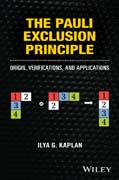
The Pauli Exclusion Principle: Origin, Verifications and Applications
Kaplan, Ilya G.
This is the first scientific book devoted to the Pauli Exclusion Principle, which is a fundamental principle of quantum mechanics and is permanently applied in chemistry, physics, molecular biology and in physical astronomy. However, while the principle has been studied for more than 90 years, rigorous theoretical foundations still have not been established and many unsolved problems remain. Following an introduction and historical survey, this book discusses the still unresolved questions around this fundamental principle. For instance, why, according to the Pauli Exclusion Principle, are only symmetric and antisymmetric permutation symmetries for identical particles realized, while the Schrödinger equation is satisfied by functions with any permutation symmetry? Chapter 3 covers possible answers to this, while chapter 4 presents effective and elegant methods for finding the Pauli–allowed states in atomic, molecular and nuclear spectroscopy. Chapter 5 discusses parastatistics and fractional statistics, demonstrating that the quasiparticles in a periodical lattice, including excitons and magnons, are obeying modified parafermi statistics. With detailed appendices, The Pauli Exclusion Principle: Origin, Verifications and Applications is intended as a self–sufficient guide for graduate students and academic researchers in the fields of quantum mechanics, theoretical chemistry, physics, and applied mathematics. It will be a valuable resource for any reader interested in the foundations of quantum mechanics and its applications in areas such as atomic and molecular spectroscopy, spintronics, molecular biology, and applied fields of quantum information. INDICE: Preface .Chapter 1 Historical Survey .1.1. Discovery of the Pauli Exclusion Principle and early developments .1.2. Further developments and still existing problems .References .Chapter 2 Construction of Functions with a Definite Permutation Symmetry .2.1. Identical particles in quantum mechanics and indistinguishability principle .2.2. Construction of permutation–symmetrical functions using the Young operators .2.3. The total wave functions as a product of spatial and spin wave functions .2.3.1 Two–particle system .2.3.2 General case of N–particle system .References .Chapter 3 Can the Pauli Exclusion Principle Be Proved? .3.1. Critical analysis of the existing proofs of the Pauli exclusion principle .3.2. Some contradictions with the concept of particle identity and their independence in the case of the multi–dimensional permutation representations .References .Chapter 4 Classification of the Pauli–Allowed States in Atoms and Molecules .4.1. Electrons in a central field .4.1.1 Equivalent electrons. L–S coupling .4.1.2. Additional quantum numbers. The seniority number .4.1.3 Equivalent electrons. j–j coupling .4.2. The connection between molecular terms and nuclear spin .4.2.1 Classification of molecular terms and the total nuclear spin .4.2.2 The determination of the nuclear statistical weights of spatial states .4.3. Determination of electronic molecular multiplets .4.3.1 Valence bond method .4.3.2 Degenerate orbitals and one valence electron on each atom .4.3.3 Several electrons specified on one of the atoms .4.3.4 Diatomic molecule with identical atoms .4.3.5 General case I .4.3.6 General case II .References .Chapter 5 Parastatistics, Fractional Statistics, and Statistics of Quasiparticles of Different Kind .5.1. Short account of parastatistics .5.2. Statistics of quasiparticles in a periodical lattice .5.2.1 Holes as collective states .5.2.2 Statistics and some properties of holon gas .5.2.3 Statistics of hole pairs .5.3 Statistics of Cooper s pairs .5.4 Fractional statistics .5.4.1 Eigenvalues of angular momentum in the three– and two–dimensional space .5.4.2 Anyons and fractional statistics .References .Appendix 1 Necessary Basic Concepts and Theorems of Group Theory .A1.1 Properties of group operations .A1.2 Representation of groups .References .Appendix 2 The Permutation Group .A2.1 General information .A2.2 The standard Young–Yamanouchi orthogonal representation .References .Appendix 3 The Interconnection Between Linear Groups and Permutation Groups. .A3.1 Continuous groups .A3.2 The three–dimensional rotation group .A3.3 Tensor representations .A3.4 Tables of the reductions of the representation to the group R3 .References .Appendix 4 Irreducible Tensor Operators .A4.1 Definition .A4.2 The Wigner–Eckart theorem .References .Appendix 5 Second Quantization .References .Index
- ISBN: 978-1-118-79532-3
- Editorial: Wiley–Blackwell
- Encuadernacion: Cartoné
- Páginas: 248
- Fecha Publicación: 16/12/2016
- Nº Volúmenes: 1
- Idioma: Inglés
